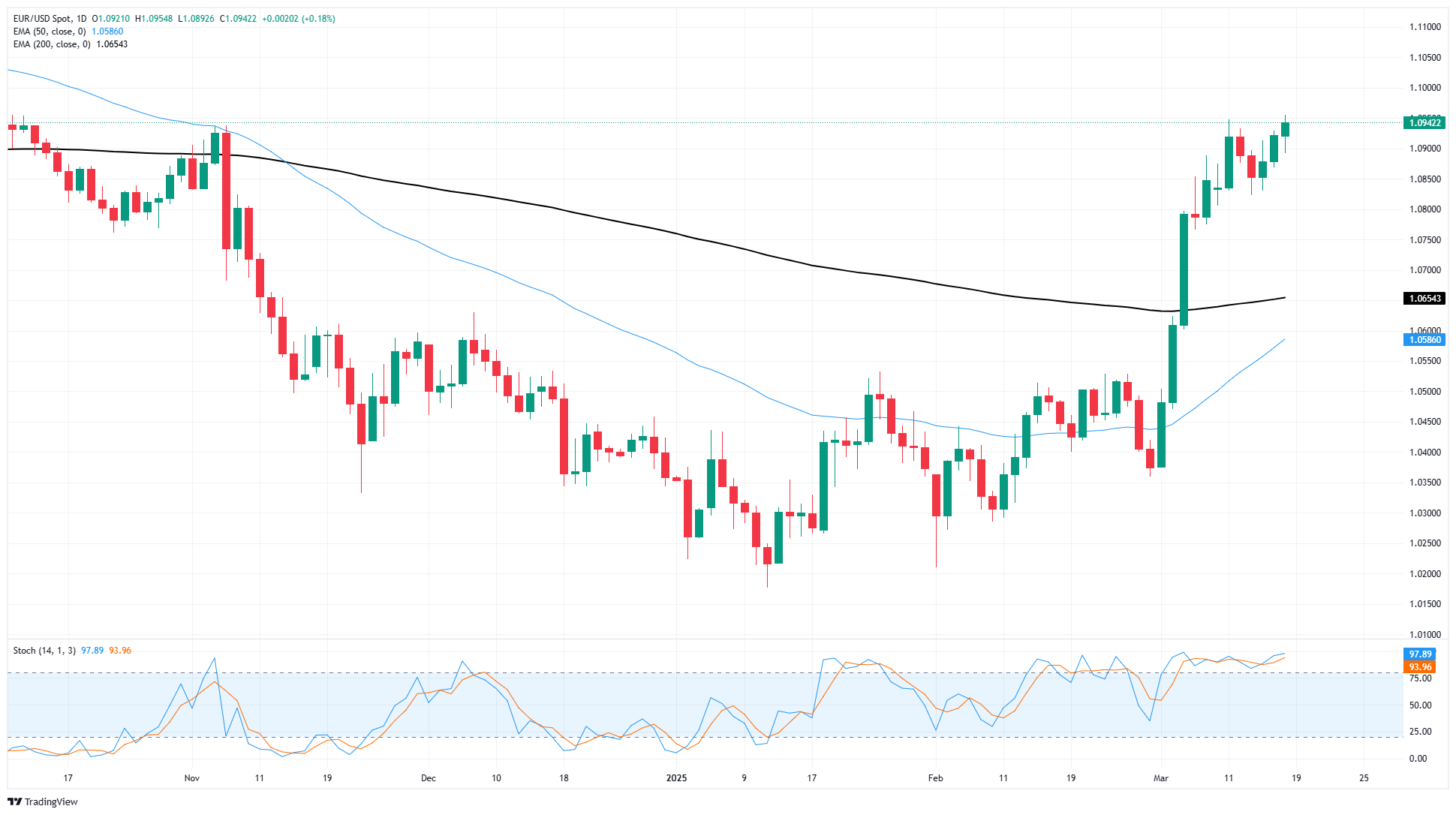EUR/USD edged up 0.2% on Tuesday, testing 1.0950.
Despite the upcoming high-impact Fed rate decision, the market still favors risk appetite.
The Fed's rate forecast update will be released on Wednesday.
EUR/USD edged up 0.2% on Tuesday, continuing to test the 1.0950 area. EUR/USD hit a 23-month high as market risk appetite steadily increased ahead of the Fed's upcoming rate meeting on Wednesday. Final European Harmonized Index of Consumer Prices (HICP) data will also be released on Wednesday, although the final data is expected to be no substantial change from the preliminary data. European Central Bank (ECB) President Christine Lagarde will be present on Thursday, when the EU leaders' summit will be held in the second half of the trading week.
Today's Forex: Fed Expected to Keep Interest Rates Unchanged
The Federal Reserve (Fed) will announce its latest interest rate decision on Wednesday. CME's FedWatch tool shows that market participants generally expect the Fed to maintain current interest rates at the next two meetings, with a possible 25 basis point rate cut expected at the June Federal Open Market Committee (FOMC) meeting. This week, the FOMC will also release updated interest rate forecasts, which could significantly change rate cut expectations if Fed policymakers' outlook on interest rates deviates significantly from existing market forecasts.
From a technical perspective, the Stochastic Oscillator is currently in overbought territory above 80.00, although it is showing signs of flattening, indicating weakening bullish momentum. Meanwhile, the Moving Average Convergence/Divergence (MACD) shows flat green bars, suggesting a lack of strong trend confidence. Taken together, these indicators suggest that the pair may enter a consolidation phase before making a clear move.
Looking ahead, resistance is set at the 1.1000 level, which has historically been an important barrier. On the downside, initial support is around 1.0850, with stronger support around the 20-day moving average near 1.0800. A break below these thresholds could trigger a corrective reaction, while sustained trading above 1.0900 would maintain the overall bullish outlook.

The Euro is the currency of the 19 European Union countries that belong to the Eurozone. It is the second most traded currency in the world after the US dollar. In 2022, the euro accounted for 31% of total foreign exchange trading, with an average daily turnover of more than $2.2 trillion. EUR/USD is the world's most traded currency pair, accounting for about 30% of all transactions, followed by EUR/JPY (4%), EUR/GBP (3%) and EUR/AUD (2%).
The European Central Bank, based in Frankfurt, Germany, is the reserve bank for the eurozone. The ECB sets interest rates and manages monetary policy. The ECB's main task is to maintain price stability, which means either controlling inflation or stimulating growth. Its main tool is to raise or lower interest rates. Relatively high interest rates - or expectations of higher interest rates - are generally good for the euro, and vice versa. The ECB's Governing Council meets eight times a year to make monetary policy decisions. Decisions are made by the presidents of the eurozone's national banks and the six permanent members, including ECB President Christine Lagarde. ”
“Eurozone inflation data, measured by the Harmonized Index of Consumer Prices (HICP), is an important econometric indicator for the euro. If inflation is higher than expected, especially above the ECB’s 2% target, the ECB will have to raise interest rates to control inflation. Relatively high interest rates compared to other countries are usually good for the euro because it makes the region more attractive as a place for global investors to invest. ”
Data released can measure the health of the economy and can have an impact on the euro. Indicators such as GDP, manufacturing and service PMIs, employment and consumer confidence surveys can all affect the direction of the euro. A strong economy is good for the euro. Not only will this attract more foreign investment, it may also encourage the European Central Bank to raise interest rates, which will directly strengthen the euro. Otherwise, if economic data is weak, the euro may fall. Economic data from the four largest economies in the eurozone (Germany, France, Italy and Spain) is particularly important because they account for 75% of the eurozone economy."
"Another important statistic for the euro is the trade balance. This indicator measures the difference between a country's export revenue and import expenditure over a given period. If a country produces popular exports, then its currency will gain value purely from the additional demand created by foreign buyers seeking to purchase these goods. Therefore, a positive net trade balance will strengthen the currency and vice versa."